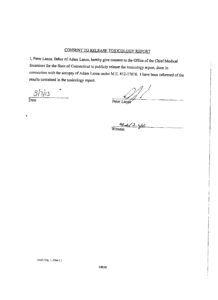This week The Hartford Courant reported that the Sandy Hook Commission is “hampered by secrecy and lack of funds” and, as a result, there are “serious doubts” of producing a definitive exploration of what occurred at Sandy Hook Elementary.
Oh, puh-leeze! Say it isn’t so, Governor Malloy. Isn’t the Governor the man who said “we don’t yet know the underlying cause behind this tragedy, and we probably never will. But that can’t be an excuse for inaction. I want the commission to have the ability to study every detail, so they can help craft meaningful legislative and policy changes?” “Every” detail? That’s just sad. The Governor’s commission can’t get any details.
The Commission doesn’t have access to Adam Lanza’s records? The Commission has no budget? Really? Is this just now, three months from its deadline, occurring to the Commission?
Psychiatrist and Commission member, Dr. Harold I Schwartz, reports that the Commission has been fortunate to have the law firm of McElroy, Deutsch, Mulvaney & Carpenter catalog the State Police Report of the shooting incident, but it’s “laborious” to use.
Can’t argue with the good doctor on that point. Not only was going through that report “laborious,” it was downright irritating. Ablechild spent three full days going through each and every document (if you can call the redacted pages “documents”), and could have saved the Commission a lot of time and frustration.
The fact is, for the last five years of Adam Lanza’s life, there are no medical/mental health records provided in the State Police Report and Ablechild gladly would have shared that information with the Commission months ago, saving it a great deal of time.
Without those mental health records, Dr. Schwartz is absolutely correct when he reported last year that “to write a report now, with what we have, would almost be embarrassing.” Unbelievably, today, despite still having no records about the last five years of Lanza’s mental health treatment, Schwartz says, “I still think that we can issue a report with important recommendations about mental health services, gun safety and school safety. We have spent a lot of time assessing the current state of all three – hearing extensive testimony from officials and experts who have dealt with mass killings.”
Schwartz is admitting that the Commission is clueless about Adam Lanza’s mental health history but, because the Commission has heard from officials and experts about other mass killings, important recommendations still can be made.
This is utter nonsense. The Commission has spoken with Peter Lanza. Did Lanza refuse to share information about Adam’s mental health? This seems odd given the fact that Lanza obviously shared information with The New Yorker reporter, Andrew Solomon. Solomon reported that in 2007 Adam had been prescribed the antidepressant, Lexapro. This information was NOT part of the State Police Report.
Additionally, the Commission might consider an interview with the honchos at The Courant, as it reported, based on information it had obtained, that Adam had been treated at the Danbury Hospital, which also was NOT part of the State Police Report.
Schwartz also may be enlightened if he were to understand the State’s absolute refusal to make public Lanza’s toxicology and medical/mental health records. Ablechild sued the state for these records last year and the reason for the lock-down on the records was made clear by the State’s Assistant Attorney General, Patrick B. Kwanashie, explaining “it would cause a lot of people to stop taking their medications.”
Based on the information provided in the State Police Report, Adam had been prescribed the antidepressant, Celexa in 2007. Add to that reporter Solomon’s new information that he was also prescribed Lexapro, and suddenly it becomes clear that Adam had been on multiple mind-altering drugs.
But that drug information ends five years before the shooting incident. What is the big secret? Was Adam prescribed so many psychiatric drugs that the information would be an embarrassment to his psychiatrist(s) and the pharmaceutical industry?
Obviously, it’s impossible to know without the mental health records. But the Commission’s final report is supposed to focus on recommendations into the mental health area. Really? Based on what information? If the Commission has no records on Adam Lanza’s mental health for the last five years of his life, what’s the point?
If the Commission intends to provide mental health recommendations, which are not the result of having reviewed the mental health records of the shooter, then don’t bother. Stop now. Accept that the Commission’s efforts were a complete waste of time and stick to the original opinion that “to write a report now, with what we have, would almost be embarrassing.”
Since Schwartz’s first admission nothing has changed. The fact that Lanza’s mental health records are shrouded in secrecy, and the state is instituting costly mental health changes merely based on the assumption that Lanza’s mental health played a role, isn’t “almost embarrassing.” It is embarrassing.


